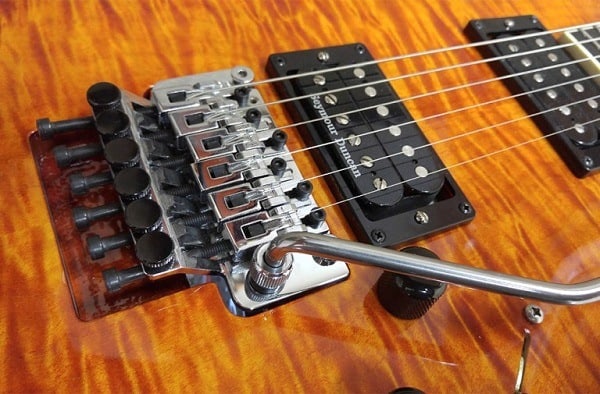Tremolo and Vibrato are two words that many guitarists use interchangeably without knowing that they mean two different things.
They are both Modulation Effects, giving some movement to a note or chord, but each one modulates a different component of your sound. Tremolo modulates the amplitude or volume of your signal, while vibrato modulates the actual pitch you’re playing.
1. Vibrato
Do you know?

That bar hanging off the front of your guitar is NOT a tremolo bar. It is a vibrato bar because it mechanically changes the pitches you’re playing when you push or pull on it.
Fender famously mislabeled their innovative Strat bridge a Synchronized Tremolo back in the 50s and got the confusion started. Finger vibrato does the same thing but uses your finger as the mechanism that modulates or moves the string. Both finger and mechanical vibrato create small or large variations in your notes; they do not alter their volume.
Here is a fun video that lets you hear the difference:
2. Tremolo!
Real tremolo is pretty much an electronic effect and not a mechanical or technique-based sound. There are many different ways to get the sound ranging from amps with built-in tremolo circuits to outboard floor or rack effect devices. Fender, again, is the most famous maker of amplifiers with tremolos incorporated into their designs (which they called Vibrato, of course) and have influenced many other makes to also give the tremolo a try.
Some companies, most notably Magnatone in the 60s and Boss in the 80s made amps and pedals, respectively, with true pitch-shifting vibrato circuits that are now highly sought.
Here is a clip of the Boss VB-2 Vibrato Pedal that will get you wanting to seek one for yourself!
See more: Volume vs. Gain – The Critical Difference
3. When Should You Use Those Effect?
So now that you know the difference between tremolo and vibrato, What do you do with them? When should you use them?
For guitarists of all kinds, finger vibrato created by rocking a fretting finger parallel with the string it’s playing (classical vibrato) or at a 90-degree angle to the string it’s playing (blues vibrato) is an essential playing skill that must be mastered to achieve a good melodic sound.
Finger vibrato is so much a part of guitar music that, if it was all suddenly removed, the music would all sound completely different. Its sound varies greatly from player to player and is one of the ways that great guitarists create his/her signature sound. It literally comes down to the way they touch the strings. Some players, such as B.B. King, are well-known for the sound of their finger vibrato and are often imitated.
Sounds interesting? Now listen to the King of the Blues show you how it’s done!
The tremolo effect is a killer old-school sound to pull out of your hat now and then, can push certain guitar parts further into rock and roll greatness than if they were played without it. It can give simple open chords in First Position a whole new level of cool, especially when you get the tremolo throbbing more-or-less in time with the song you’re playing.
Cranked to more extreme settings, it can give a stuttering, almost synth-like quality to a normal guitar sound.
One of the most famous examples of tremolo are in the Classic Rock Songbook is ‘Born On The Bayou’ by Creedence Clearwater Revival. The effect gives what would be a pretty plain one-chord guitar part a swampy and dark vibe that has made the track world famous. Give it a try!
Both tremolo and vibrato are important sounds for guitarists to come to grip with, as they come up a lot. Both have been part of the electric guitar vocabulary practically since the beginning and developing good-sounding finger vibrato are extremely essential for any player seeking a ‘singing’, melodic sound on electric or acoustic guitars!
Good vocalists put vibrato on their longer-held notes naturally and that’s the type of sound we are trying to make it happen on the guitar. Also, start listening for tremolo and vibrato in your music collection to train your ears to know when to best use these often-confused sounds.
Conclusion
You should now understand the basic difference between tremolo and vibrato. Vibrato changes the pitch you’re playing and tremolo changes the volume of it. Simple, right? Now let’s come to the fun part where you plug-in and experiment with all this new knowledge!
We hope you enjoy this article. Please let us know what you think in the Comments section, as well as your favorite tremolo or vibrato guitar moment. Let us know if you have any questions and we’ll do our best to get you all sorted out!